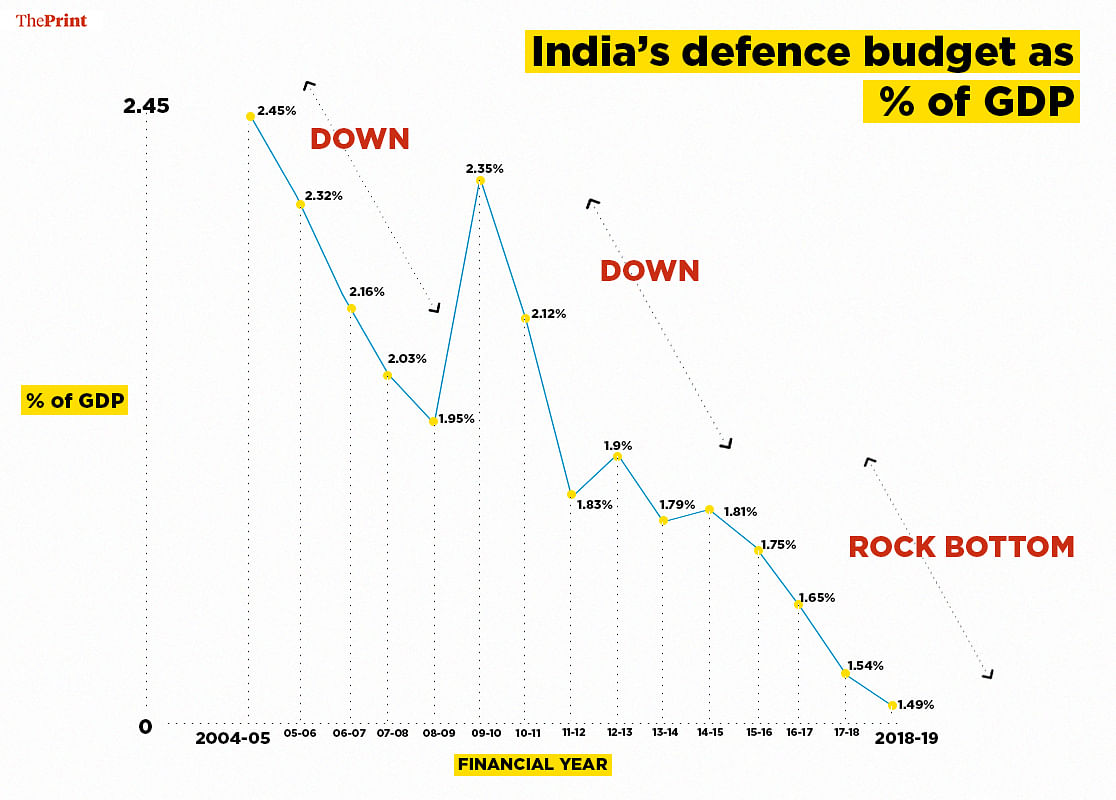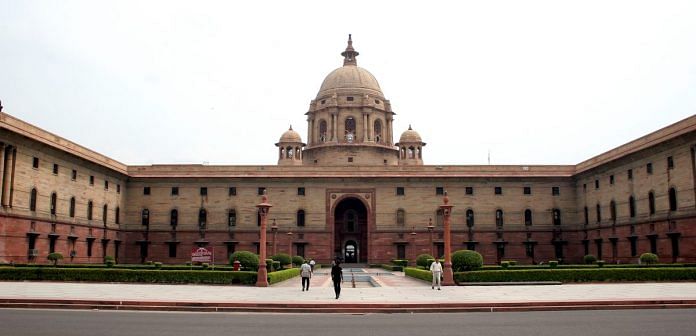A Parliamentary panel is concerned about India’s declining defence expenditure — which is at 1.56% of GDP in 2017-18, down from 2.6% in 2014-15 — and said the country “cannot afford complacency” in a two-front war.
New Delhi: A parliamentary committee has taken exception to the low defence expenditure in India, noting that, in the current geo-political scenario, the country “cannot afford complacency” on the question of preparedness for a two-front war.

It has also expressed concern about the slow rate of increase in indigenisation in the defence sector, and noted that “nothing concrete has been done for implementation of the strategic partnership model” unveiled in May last year.
These observations are part of the estimates committee’s draft report on ‘Preparedness of Armed Forces: Defence Production and Procurement’.
Members of Parliament privy to the deliberations told ThePrint that the committee, headed by BJP leader Murli Manohar Joshi, is perturbed about the fact that India’s defence expenditure, at 1.56 per cent of the GDP in 2017-18 — down from 2.6 per cent in 2014-15 — is at its lowest since the 1962 Sino-Indian war.
From the data made available to the committee, it was found that defence expenditure had marginally increased since 2014-15, but when compared to the central government’s expenditures, the percentage decreased from 13.15 in 2014-15 to 12.2 in 2017-18.
According to a study by the Stockholm International Peace Research Institute, which conducts research on global security, the defence expenditure, as a share of the GDP, of China and France had remained the same, increased in case of Saudi Arabia and Russia and decreased in case of the US and the UK in the last decade (2007-2017).
However, the estimates committee says in its draft report, keeping in view the scale of GDP of the developed countries, the decrease of India’s defence expenditure as a percentage of the GDP is “more noticeable”.
‘Allocations unacceptable’
The estimates committee is also “unhappy” about the “abysmally low” share of capital expenditure as a percentage of the total defence spend, which has been continuously declining over the years — from 39 per cent in 2013-14 to 33 per cent in 2017-18.
“What is more worrisome is the situation whereby the procurement has to be adjusted as per the budgetary allocations made by the government, which are not in keeping with the requirements projected as per the long-term integrated perspective plan (LTIPP)…” an MP told ThePrint.
“The committee finds the present situation unacceptable whereby the allocations are not being made according to the LTIPP, thereby defeating the purpose of having long-term defence plans,” the MP said.
Before finalising the report, the panel is likely to call the defence minister for deposition, the MP added.
In 2014-15 and 2015-16, the allocations made at the budgetary-estimates stage consistently got reduced at the revised-estimates level and even the reduced allocations could not be utilised fully. The committee members were, therefore, “not able to appreciate” the remarks of the secretary, defence acquisition, during the course of deposition that “they hear from the department of defence that the requirement of the forces is very high and the fund allocation to that extent is not there”.
Where’s the PPP?
According to another MP, the committee is likely to recommend that defence public sector undertakings (DPSUs) be given “adequate autonomy and resources” to enable them to operate on commercial basis and sell their products to global customers without depending on the government.
“In case of conflict, the demands of the national armed forces have to be given primacy,” the committee is learnt to have said in its draft report.
Notwithstanding the government’s constant refrain about public-private partnership in defence, the committee, said a member, has found that “there is no existing mechanism” to facilitate it in the defence sector.
“The strategic-partnership model formulated for defence production does not specify a clear role for major defence PSUs. There seems to be a total lack of coordination among government agencies insofar as integrated approach to public-private partnership in defence sector is concerned,” said another member, quoting from the report.
DRDO hauled up
In its draft report, the committee has come down heavily on the Defence Research and Development Organisation (DRDO), saying it has “not been able to meet the nation’s expectation”.
In 2015, the Comptroller & Auditor General of India reported that 14 mission-mode projects carried out by DRDO laboratories had failed to achieve their timelines and the probable date of completion was extended many a time.
These mission-mode projects pertained to the S-band surveillance system, Rohini radars, secure video and fax communication between airborne platforms and ground station Meghdoot and electronic warfare suit for the modified MiG-29 fighters.
A high-powered defence committee said that at least 11 laboratories of the DRDO need to be closed down. The estimates committee has pointed out in its draft report that the functioning of DRDO needs a major overhaul and its contribution in the context of the country’s requirements needs to be re-examined.




It is no longer a draft report. The report is already presented to Lok sabha in July last week. The text may be accessed on lok sabha website.
Being compelled to fight a two front war has been Indian planners’ worst nightmare for the last sixty years. However, with all three actors being nuclear armed, a high level of deterrence is in place. Along the border with China, an essential conventional parity has also been achieved. At the apex of government, with so many priorities to be balanced, a certain frugality in defence spending is not unwelcome. Perhaps, within the available funds, the balance can shift a little from personnel costs to weapons.
With due respect, I beg to differ and here is my argument.
We need to buy what is a minimum requirement. If we are not buying 126 Rafaels and rather being content with 36 units, it means we do not have the money. Plain and simple.
The requirement of 42+ squadrons has time and again been justified by IAF in the very context of two front war and the sanctioned strength of IAF. Wars are won by numbers and technology. You have to have a good balance and Chinese have much higher numbers and a range of technical capabilities.
Please note that we scrapped a bigger deal that could have brought some technology(potentially useful for AMCA/LCA) and newer manufacturing tech to HAL in favor of this smaller deal. Again, there has to be a reason to do that !
China border: Army placed requirement for Mountain Strike Corps to achieve some parity but we cannot even afford that. Mountain Strike Corps has been put on hold. These formations would have given us offensive capability in some sectors, and this becomes important in order to attack and acquire enemy area. After a war, we would have to barter the land acquired by each other’s armies.
Lastly, why would a government that markets itself on nationalism starve armed forces of their needs. Economy !! But when I look at prime time TV news, I do not find a serious discussion over any of these issues.
For once, I agree with some Parliamentarians. But would they say the same thing if we had a Maunmohan-Sonia UPA in charge?
Jaitley Modi, do not have money because of their profligacy. Their priorities are appeasement of Netas (100% hike in pay and perks), Babus (35% hike in pay and perks), Milards (200% hike in pay and perks) and doles to Dalits, Moslems and other constitutionally preferred secyions of society rather than National Security.
GOOD NEWS.
Its better that Parliament finds us lacking and unprepared than it finds India’s defense funding to be “Adequate” and slip into complacency.